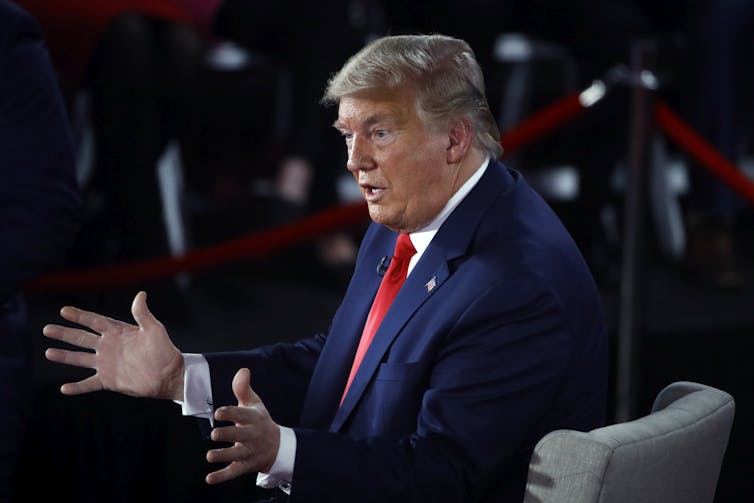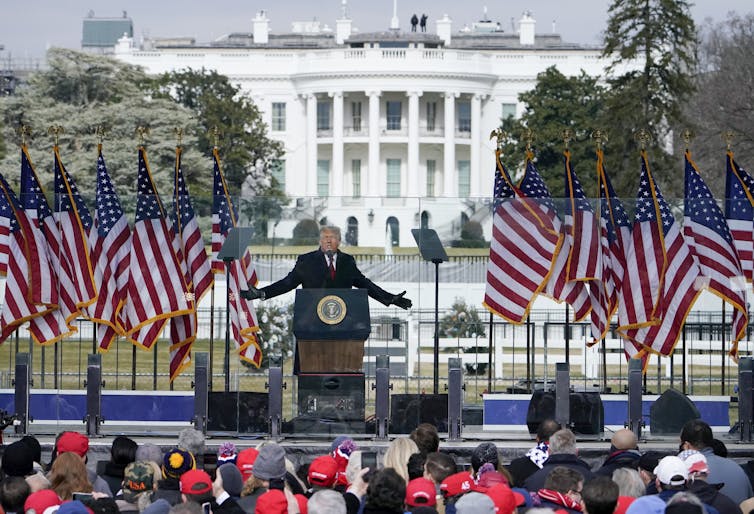I analyzed all of Trump's tweets to find out what he was really saying
- Written by Michael Humphrey, Assistant Professor of Journalism and Media Communication, Colorado State University
The tally was in, it was clear Donald Trump had lost – and he tweeted: “either a new election should take place or … results nullified[1].”
It sounds familiar, but it wasn’t November 2020. It was February 2016.
Trump was just months into his presidential campaign, and was already telling a story he would tell countless times over the following five years, hinting to the world at the character of the man the U.S. Senate will soon evaluate in the impeachment trial.
Back then, Trump was seeking to nullify Ted Cruz’s victory. And he was accusing Iowa of bungling the primary vote counting.
“The State of Iowa should disqualify Ted Cruz[2] from the most recent election on the basis that he cheated – a total fraud!” Trump tweeted.
The Donald Trump Americans think of now was the same Donald Trump who entered the election in 2015 and the White House in 2016. Some of his power to rally a loyal base was based on his repetitive rhetorical style[3], but on Twitter he was especially potent as narrator-in-chief of his own political life.
In 2017, I began to collect all of his tweets, going back to June 16, 2015, the day he announced his candidacy. I kept at it until Jan. 8, 2021, the day Twitter permanently suspended his account[4]. I wanted to learn more about how he used language. But in those 20,301 tweets I learned something more fundamental about how the 45th president of the United States used Twitter to tell his own story.
A storyteller president
Trump was more effusively positive[5] and more bitingly negative[6] than the politicians, journalists, news organizations and activists I compared him to – including Democratic presidential candidate Hillary Clinton, Katy Tur of NBC, pro-Trump activist Linda Suhler and Black Lives Matter activist DeRay Mckesson.
However, the main distinction I found was that Trump was among the most frequent users of storytelling methods[7]. Since I am a digital narrative researcher[8], that intrigued me.
Storytelling in general is common among effective politicians[9], but Trump’s effort appears to have built a high level of loyalty[10], diverted attention away[11] from negative topics and generally set the agenda[12] for what the American public was discussing.
Others have looked at this aspect of Trump’s appeal, examining specific stories[13] throughout his presidency, his style of storytelling[14] and even the rhetorical components[15] of his populist narrative.
But I discovered a particular story structure that he used the whole time.
 Donald Trump knew how to tell a story – his own.
AP Photo/Matt Rourke[16]
Donald Trump knew how to tell a story – his own.
AP Photo/Matt Rourke[16]
Consistency amid change
There were five main themes, which appeared regularly – often all in one day:
- The true version of the United States is beset with invaders;
- Real Americans can see this;
- I (Trump) am uniquely qualified to stop this invasion;
- The establishment and its agents are hindering me;
- The U.S. is in mortal danger because of this.
Taken together over time, this formed an overall story structure that I summarize this way: “The establishment is stopping me from protecting you against invaders[17].”
The elements were flexible. “The establishment” could be anyone – Democrats, the NFL, a media outlet, a corporation and even Vice President Mike Pence. “The invaders” were China, the coronavirus that first emerged there, people crossing the U.S.-Mexico border or Black Lives Matter protesters.
But the structure never changed: There was a danger to the nation, Trump was uniquely able to protect America and he was righteously supported by “real” Americans.
That is what he said; how it worked was equally important.
Donald Trump claims ‘I alone can fix it’ in his speech accepting the Republican nomination for president.Telling a different story
In terms storytelling scholars use, Trump “rescripted[18]” the world to fit his themes. He took elements of news articles, viral videos, other tweets and whatever else he needed to build his messages. He took storylines that were already in the public sphere and placed new meaning on them to fit his own tale.
During the 2015 lead-up to the Republican primary, for example, the conservative Club for Growth spent US$1 million[19] running negative ads against Trump. But Trump, tweeting, rescripted the story: “The phony Club For Growth[20], which asked me in writing for $1,000,000 (I said no), is now wanting to do negative ads on me. Total hypocrites!” The Club for Growth was a groveling and fraudulent establishment; he was effective and powerful.
Trump would also rescript characters into multiple, sometimes contradictory, messages, depending on the day’s news. Consider his tweeting about China, which was first a partner, then a trade adversary and finally an invader:
- 2017: “The failing @nytimes hates the fact[21] that I have developed a great relationship with World leaders like Xi Jinping, President of China…..”
- 2018: “We are not in a trade war with China[22], that war was lost many years ago by the foolish, or incompetent, people who represented the U.S. Now we have a Trade Deficit of $500 Billion a year, with Intellectual Property Theft of another $300 Billion. We cannot let this continue!”
- 2020: “New China Virus Cases up (because of massive testing)[23], deaths are down, ‘low and steady’. The Fake News Media should report this and also, that new job numbers are setting records!”
Sticking to the script
Trump most commonly tweeted about the government, media and corporate institutions, which often became fodder for news coverage. The media often framed the tweets as attacks[24] and “counter-punching[25].” But in a closer read, they were not merely responses to criticism or bad news. They regularly described something, the way a narrator would.
But his recasting of reality through his own lens may have also played a role in Trump’s downfall. All the attacks, all the twisting of information, all the fear, may have worn out just enough people in key states to ensure his defeat.
When that defeat struck, Trump’s storytelling framework did not change: It escalated and multiplied, consuming everything and everyone who did not blatantly support what many have called the Big Lie[26] – that the election was rigged against him:
- Jan. 3, 2021: “I spoke to Secretary of State Brad Raffensperger[27] yesterday about Fulton County and voter fraud in Georgia. He was unwilling, or unable, to answer questions such as the ‘ballots under table’ scam, ballot destruction, out of state ‘voters’, dead voters, and more. He has no clue!”
- Jan. 6, 2021: “Mike Pence didn’t have the courage[28] to do what should have been done to protect our Country and our Constitution, giving States a chance to certify a corrected set of facts, not the fraudulent or inaccurate ones which they were asked to previously certify. USA demands the truth!”
 Donald Trump speaks at his Jan. 6, 2021 rally, before the crowd marched on the Capitol.
AP Photo/Jacquelyn Martin[29]
Donald Trump speaks at his Jan. 6, 2021 rally, before the crowd marched on the Capitol.
AP Photo/Jacquelyn Martin[29]
A path to the end
There is no one single line from a Trump speech or tweet that is going to be the smoking gun urging his followers to violence.
But he did help set the scene for the Capitol raid. The most famous was on Dec. 19, 2020: “Peter Navarro releases 36-page[30] report alleging election fraud ‘more than sufficient’ to swing victory to Trump … A great report by Peter. Statistically impossible to have lost the 2020 Election. Big protest in D.C. on January 6th. Be there, will be wild!”
The way Trump crafted this tweet is representative of how he rescripted things to tell his own story. He took something already in the discussion, Navarro’s report, and used it in a way that shaped the logic for the “stop the steal” campaign.
Trump didn’t have to invent #StopTheSteal – just include it in his existing narrative structure. Other politicians, including Rep. Marjorie Taylor Greene[31], have adopted Trump’s general structure for their own tweets.
However, the final tweet from his account before it was closed does not really fit any of his common themes. It is also one of the few times it seems like the tweet is telling a more traditional story. “To all of those who have asked, I will not be going to the Inauguration on January 20th[32]” is a pretty understated ending to an epic tale.
[_The Conversation’s most important election and politics headlines, in our Politics Weekly newsletter[33].]
References
- ^ either a new election should take place or … results nullified (www.thetrumparchive.com)
- ^ The State of Iowa should disqualify Ted Cruz (www.thetrumparchive.com)
- ^ repetitive rhetorical style (doi.org)
- ^ suspended his account (blog.twitter.com)
- ^ effusively positive (www.thetrumparchive.com)
- ^ bitingly negative (www.thetrumparchive.com)
- ^ storytelling methods (hdl.handle.net)
- ^ digital narrative researcher (scholar.google.com)
- ^ among effective politicians (www.quantifiedcommunications.com)
- ^ high level of loyalty (news.berkeley.edu)
- ^ diverted attention away (www.eurekalert.org)
- ^ set the agenda (doi.org)
- ^ specific stories (www.nydailynews.com)
- ^ his style of storytelling (www.cleveland.com)
- ^ rhetorical components (theconversation.com)
- ^ AP Photo/Matt Rourke (newsroom.ap.org)
- ^ The establishment is stopping me from protecting you against invaders (denver.cbslocal.com)
- ^ rescripted (doi.org)
- ^ spent US$1 million (www.nytimes.com)
- ^ The phony Club For Growth (www.thetrumparchive.com)
- ^ The failing @nytimes hates the fact (www.thetrumparchive.com)
- ^ We are not in a trade war with China (www.thetrumparchive.com)
- ^ New China Virus Cases up (because of massive testing) (www.thetrumparchive.com)
- ^ framed the tweets as attacks (pressfreedomtracker.us)
- ^ “counter-punching (www.politico.com)
- ^ Big Lie (www.washingtonpost.com)
- ^ I spoke to Secretary of State Brad Raffensperger (www.thetrumparchive.com)
- ^ Mike Pence didn’t have the courage (www.thetrumparchive.com)
- ^ AP Photo/Jacquelyn Martin (newsroom.ap.org)
- ^ Peter Navarro releases 36-page (theconversation.com)
- ^ Rep. Marjorie Taylor Greene (twitter.com)
- ^ To all of those who have asked, I will not be going to the Inauguration on January 20th (www.thetrumparchive.com)
- ^ The Conversation’s most important election and politics headlines, in our Politics Weekly newsletter (theconversation.com)
Authors: Michael Humphrey, Assistant Professor of Journalism and Media Communication, Colorado State University


